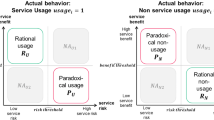Abstract
The existing DRM systems address the interests of providers, associated with prohibitively tight protection measures, which do not take customers’ behaviors and needs into account. This paper proposes a novel DRM scheme that both accommodates consumers’ expectations for the friendliness of personal use and preserves the providers’ revenue. By maintaining a fairer balance between the interests of both content providers and consumers, the proposed DRM scheme thus benefits the digital content industry as a whole. The comparison between the related works and the proposed scheme implies the superiority of the proposed scheme while the security analyses and the further discussion demonstrate the proposed works well.

Similar content being viewed by others
References
Brookson.com, Smart card cloning is easy (2005) Available at: http://www.brookson.com/gsm/cardclone.pdf
Chen HB, Lee WB (2008) Efficient and portable digital rights management for preserving user privacy using smart cards. J Comput 19(1):3–12
Chen YY, Wang YJ, Chen CJ (2008) A fair-use DRM system based on web service. Proceedings of the 8th International Conference on Intelligent Systems Design and Applications, Kaohsiung, Taiwan, 3, 11–16
Chen HB, Lee WB, Ho KIJ, Yeh CK (2010) A secure and cost-effective content protection scheme for DRM systems. J Comput Inf Syst 6(5):1377–1386
Dodis Y, Ostrovsky R, Reyzin L, Smith A (2008) Fuzzy extractor: how to generate strong keys from biometrics and other noisy data. SIAM J Comput 38(1):97–139
Dufft N, Stiehler A, Vogeley D, Wichmann T (2005) Digital music usage and DRM-results from an European consumer survey. The Informed Dialogue about Consumer Acceptability of DRM Solutions in Europe
Maghiros I, Punie Y, Delaitre S, Lignos E, Rodriguez C, Ulbrich M, Cabrera M (2005) Biometrics at the frontiers: Assessing the impact on society (No. EUR 21585 EN)
Golić JD, Baltatu M (2008) Entropy analysis and new constructions of biometric key generation systems. IEEE Trans Inf Theory 54(5):2026–2040
Groenenboom M, Helberger N, Orwat C, Schaub M, Spielkamp M (2006) Consumer’s guide to digital rights management: Any side effects. Institute for Information Law: University of Amsterdam: INDICARE Project. Retrieved from http://www.indicare.org/tiki-download_file.php
Hao F, Anderson R, Daugman J (2006) Combining crypto with biometrics effectively. IEEE Trans Comput 55(9):1081–1088
Jiang Y, Katsamakas E (2010) Impact of e-book technology: ownership and market asymmetries in digital transformation. Electron Commer Res Appl 9(5):386–399
Kanjanarin W, Amornraksa T (2001) Scrambling and key distribution scheme for digital television. In: Proceedings of IEEE international conference on networks. IEEE, Bangkok, pp 140–145
Kumari S, Khan MK, Li X (2016) A more secure digital rights management authentication scheme based on smart card. Multimed Tools Appl 75(2):1135–1158
Lee WB, Wu WJ, Chang CY (2007) A portable DRM scheme using smart cards. J Organ Comput Electron Commer 17(3):247–258
Löytynoja M, Seppänen T, Cvejic N (2003) Experimental DRM architecture using watermarking and PKI. In: Proceedings of the 1st international mobile IPR workshop: rights management of information products on the mobile internet. Helsinki, Finland, p 47–52
Open Mobile Alliance (2009) DRM architecture, Candidate Ver. 2.1. Available at: http://www.openmobilealliance.org/release_program/docs/DRM/V2_1-20070724-C/OMA-AD-DRM-V2_1-20070724-C.pdf
Rosenblatt B (2007) DRM, law and technology: an American perspective. Online Inf Rev 31(1):73–84
Samuelson P (2003) DRM {and, or, vs.} the law. Commun ACM 46(4):41–45
Stallings W (2003) Cryptography and network security: principles and practices, 3rd edn. Prentice Hall, Upper Saddle River
Sun HM, Hung CF, Chen CM (2007) An improved digital rights management system based on smart cards. In: Proceedings of the 2007 inaugural IEEE-IES digital ecosystems and technologies conference, Cairns, Australia, p 308–313
U.S. Copyright Office (2007) Copyright Law of the United States of America and Related Laws Contained in Title 17 of the United State Codes
Uludag U, Pankanti S, Prabhakar S, Jain AK (2004) Biometric cryptosystems: issues and challenges. Proc IEEE 92(6):948–960
Uludag U, Pankanti S, Jain AK (2005) Fuzzy vault for fingerprints, Proceedings of the 5th International Conference on Audio- and Video-Based Biometric Person Authentication, NY, 310–319
Wang M, Fan K, Pei Q, Wang S, Cao S (2007) A novel digital content protection system based on iris biometric. Proceedings of the 4th International Conference on Fuzzy Systems and Knowledge Discovery, Hainan, China, 4, 221–225
Yang HW, Yang CC, Lin W (2013) Enhanced digital rights management authentication scheme based on smart card. IET Inf Secur 7(3):189–194
Zeng W, Yu H, Lin CY (2006) Multimedia security technologies for digital rights management. Academic Press, New York
Zhang G, Zhang C (2004) A biometric-based framework for digital rights protection, Proceedings of the 7th International Conference on Signal Processing, 3, 2314–2317
Author information
Authors and Affiliations
Corresponding author
Rights and permissions
About this article
Cite this article
Chen, HB., Lee, WB. & Chen, TH. A novel DRM scheme for accommodating expectations of personal use. Multimed Tools Appl 77, 23099–23114 (2018). https://doi.org/10.1007/s11042-018-5614-4
Received:
Revised:
Accepted:
Published:
Issue Date:
DOI: https://doi.org/10.1007/s11042-018-5614-4




